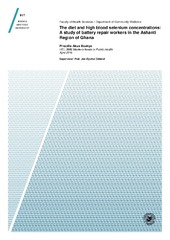Association of Selenoprotein and Selenium Pathway Genotypes with Risk of Colorectal Cancer and Interaction with Selenium Status
Permanent link
https://hdl.handle.net/10037/15989Date
2019-04-25Type
Journal articleTidsskriftartikkel
Peer reviewed
Author
Fedirko, Veronika; Jenab, Mazda; Méplan, Catherine; Jones, Jeb S.; Zhu, Wanzhe; Schomburg, Lutz; Siddiq, Afshan; Hybsier, Sandra; Overvad, Kim; Tjønneland, Anne; Omichessan, Hanane; Perduca, Vittorio; Boutron-Ruault, Marie-Christine; Kühn, Tilman; Katzke, Verena; Aleksandrova, Krasimira; Trichopoulou, Antonia; Karakatsani, Anna; Kotanidou, Anastasia; Tumino, Rosario; Panico, Salvatore; Masala, Giovanna; Agnoli, Claudia; Naccarati, Alessio; Bueno-De-Mesquita, Bas; Vermeulen, Roel C.H.; Weiderpass, Elisabete; Skeie, Guri; Nøst, Therese Haugdahl; Lujan-Barroso, Leila; Quirós, Jose Ramón; Huerta, José María; Rodríguez-Barranco, Miguel; Barricarte, Aurelio; Gylling, Björn; Harlid, Sophia; Bradbury, Kathryn Erica; Wareham, Nick; Khaw, Kay-Tee; Gunter, Marc J.; Murphy, Neil; Freisling, Heinz; Tsilidis, Kostas; Aune, Dagfinn; Riboli, Elio; Hesketh, John E.; Hughes, David J.Abstract
Selenoprotein genetic variations and suboptimal selenium (Se) levels may contribute to the
risk of colorectal cancer (CRC) development. We examined the association between CRC risk and
genotype for single nucleotide polymorphisms (SNPs) in selenoprotein and Se metabolic pathway
genes. Illumina Goldengate assays were designed and resulted in the genotyping of 1040 variants
in 154 genes from 1420 cases and 1421 controls within the European Prospective Investigation into
Cancer and Nutrition (EPIC) study. Multivariable logistic regression revealed an association of
144 individual SNPs from 63 Se pathway genes with CRC risk. However, regarding the selenoprotein
genes, only TXNRD1 rs11111979 retained borderline statistical significance after adjustment for
correlated tests (PACT = 0.10; PACT significance threshold was P < 0.1). SNPs in Wingless/Integrated
(Wnt) and Transforming growth factor (TGF) beta-signaling genes (FRZB, SMAD3, SMAD7) from
pathways affected by Se intake were also associated with CRC risk after multiple testing adjustments.
Interactions with Se status (using existing serum Se and Selenoprotein P data) were tested at the
SNP, gene, and pathway levels. Pathway analyses using the modified Adaptive Rank Truncated
Product method suggested that genes and gene x Se status interactions in antioxidant, apoptosis, and
TGF-beta signaling pathways may be associated with CRC risk. This study suggests that SNPs in the
Se pathway alone or in combination with suboptimal Se status may contribute to CRC development.
Description
Source at https://doi.org/10.3390/nu11040935.
Publisher
MDPICitation
Fedirko, V., Jenab, M., Méplan, C., Jones, J.S., Zhu, W., Schomburg, L. ... Hughes, D.J. (2019). Association of Selenoprotein and Selenium Pathway Genotypes with Risk of Colorectal Cancer and Interaction with Selenium Status. Nutrients, 11(4), 935. https://doi.org/10.3390/nu11040935Metadata
Show full item recordCollections
Related items
Showing items related by title, author, creator and subject.
-
The diet and high blood selenium concentrations. A study of battery repair workers in the Ashanti region of Ghana.
Boakye, Priscilla Akua (Master thesis; Mastergradsoppgave, 2016-04-26)This study is based on an earlier study on the assessment of the bioavailability of inorganic elements among battery repair workers in the Ashanti Region of Ghana, which revealed high blood concentrations of selenium, lead and antimony. Selenium is obtained mainly through the diet in the form of food and dietary supplements. The purpose of this study was to investigate the food patterns of the battery ... -
Prediagnostic Blood Selenium Status and Mortality among Patients with Colorectal Cancer in Western European Populations
Baker, Jacqueline Roshelli; Umesh, Sushma; Jenab, Mazda; Schomburg, Lutz; Tjønneland, Anne; Olsen, Anja; Marie-Christine, Boutron-Ruault; Rothwell, Joseph A.; Severi, Gianluca; Katzke, Verena; Johnson, Theron; Schulze, Matthias B.; Masala, Giovanna; Agnoli, Claudia; Simeon, Vittorio; Tumino, Rosario; Bueno-De-Mesquita, Bas; Gram, Inger Torhild; Skeie, Guri; Bonet, Catalina; RodrÍguez-Barranco, Miguel; Houerta, José María; Gylling, Björn; Van Guelpen, Bethany; Perez-Cornago, Aurora; Aglago, Elom; Freisling, Heinz; Weiderpass, Elisabete; Cross, Amanda J.; Heath, Alicia K.; Hughes, , David J.; Fedirko, Veronika (Journal article; Tidsskriftartikkel; Peer reviewed, 2021-10-22)A higher selenium (Se) status has been shown to be associated with lower risk for colorectal cancer (CRC), but the importance of Se in survival after CRC diagnosis is not well studied. The associations of prediagnostic circulating Se status (as indicated by serum Se and selenoprotein P (SELENOP) measurements) with overall and CRC-specific mortality were estimated using multivariable Cox proportional ... -
Mercury, silver and selenium in serum before and after removal of amalgam restorations: results from a prospective cohort study in Norway
Björkman, Lars; Musial, Frauke; Alræk, Terje; Werner, Erik Lønnmark; Hamre, Harald J. (Journal article; Tidsskriftartikkel; Peer reviewed, 2022-11-16)<p><b> Objective</b> A prospective cohort study on changes of health complaints after removal of amalgam restorations was carried out at the request of the Norwegian Directorate of Health. The aim was to provide and evaluate experimental treatment to patients with health complaints attributed to dental amalgam fillings. <p><b> Methods</b> Patients (n = 32) with medically unexplained ...


 English
English norsk
norsk


